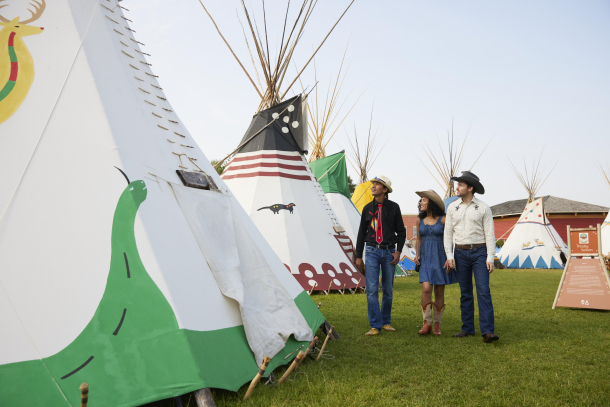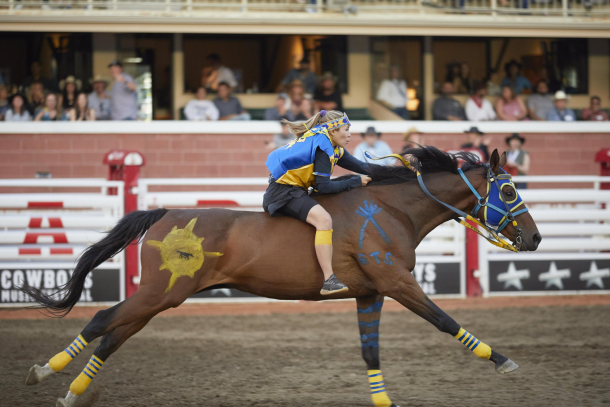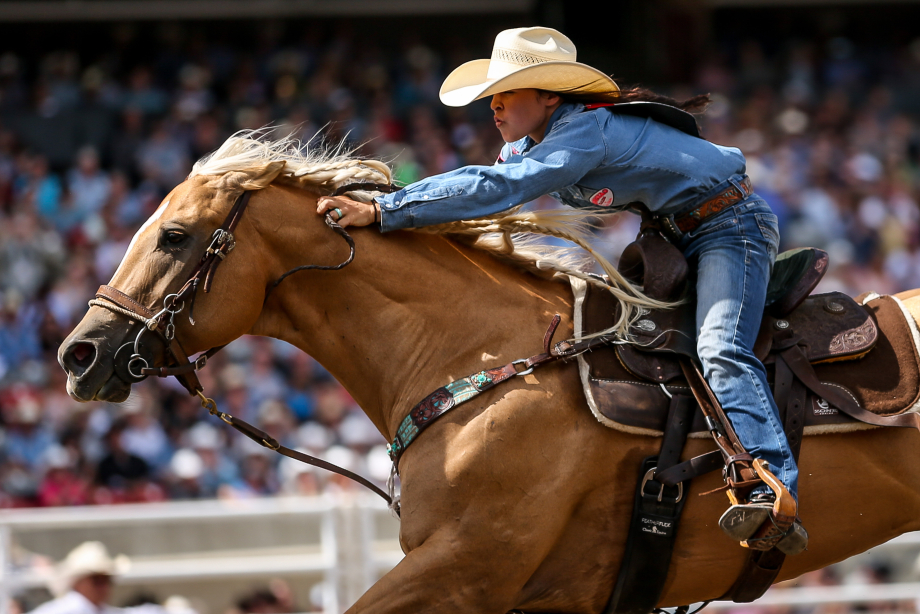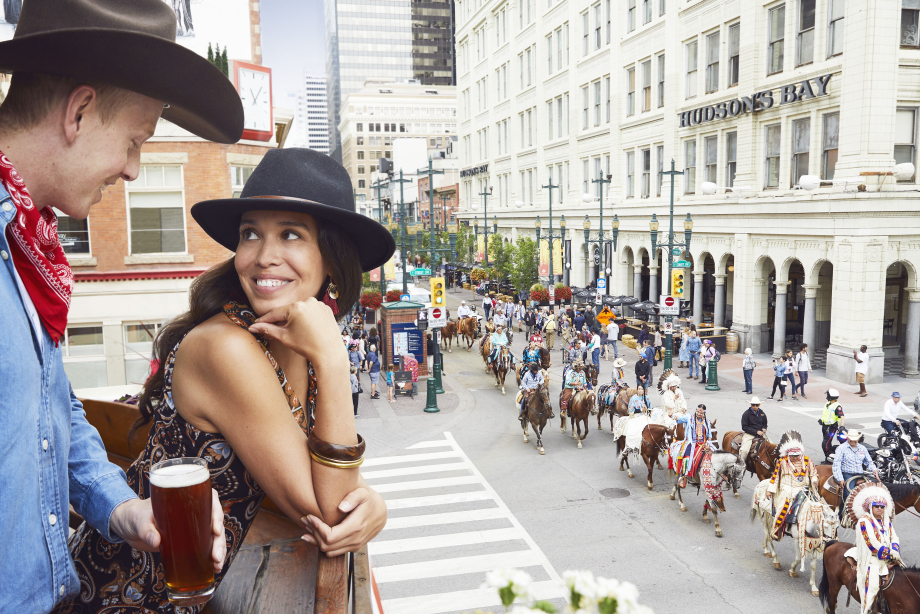First Nations Experiences at the Calgary Stampede
Learn about and celebrate the cultures of Treaty 7 First Nations.

Subscribe to our newsletter for more ways to explore
The Calgary Stampede provides an incredible opportunity to experience the area’s First Nations cultures. The Siksika, Kainai, Piikani, Stoney Nakoda, and Tsuut’ina Nations of Treaty 7 have been involved with Stampede since it began in 1912 and are eager to share their cultures and traditions with visitors.
Here are the main ways you can experience the First Nations cultures at the Calgary Stampede.
Elbow River Camp
Every year, Elbow River Camp is constructed on the banks of the Elbow River at Stampede Park. It’s centred around 26 tipis that have been passed down from generation to generation, each with their own unique hand-painted designs. You’ll also find local artisans selling authentic jewellery and art, tasty treats like bannock with Saskatoon berry jam, and programming like traditional dancing.
All Treaty 7 First Nations are represented at Elbow River Camp:
The Blackfoot Confederacy (Siksika, Kainai, and Piikani)
Stoney Nakoda (Bearspaw, Chiniki, and Goodstoney)
Tsuut’ina

Visitors can experience traditional drumming at Elbow River Camp (photo credit: Colin Way)

There are plenty of opportunities for personal connections at Elbow River Camp (photo credit: Colin Way)
History
The land where Elbow River Camp sits has always been used as a gathering place for the First Nations. Yet, in 1912 when Guy Weadick and the other organizers of the first Stampede wanted to include First Nations people, cultures, and traditions the federal legislation made it illegal for them to wear traditional clothing, speak their own languages, or have their own ceremonies. Stampede became a safe space for First Nations people to preserve and celebrate their cultures.
In the early days of Stampede, surrounding Nations would camp in and around the city before eventually coming together on Stampede Park. This tradition continues each year during the Calgary Stampede at Elbow River Camp.
Interpretive Program
It’s the personal connections that make Elbow River Camp such a meaningful experience for most visitors. First Nations members of Treaty 7 are available throughout Elbow River Camp to share their knowledge about their cultures and traditions. The Interpreters also demonstrate traditional outdoor cooking, as they make dried meat, tea, Saskatoon berry soup, and bannock.
Interpreters can be easily identified by their red vests.
For a special experience, visit Stampede early and watch a traditional flag raising. Each morning at Elbow River Camp, flags for each First Nation of Treaty 7, the province of Alberta, and Canada are raised to the sound of drumming and singing.
Bannock Booth
Bannock is a type of bread that’s been popular with First Nations across North America for hundreds of years.
While exploring Elbow River Camp, make sure to stop at the Bannock Booth for some deep-fried bannock that’s best served with Saskatoon berry jam.
Hand Games
The Hand Games Competition is an experience you won’t want to miss! Watch as two teams try to outsmart each other by hiding sticks between team members before guessing the sticks’ location. This cultural game is a favourite with First Nations throughout North America. Traditional songs and drums are played throughout the game, making for a truly engaging experience.
Hand Games are played at specific times during Stampede, so make sure to check the schedule .

The Relay Races are electrifying to watch

The Calgary Stampede Powwow inside the Scotiabank Saddledome (photo credit: Travel Alberta/Youn Park)
Relay Races
Relay Races have become a fan favourite experience since being added to the Stampede’s Evening Show in 2017. Each night, 10 of the best Relay Racing teams from First Nations in Alberta, Saskatchewan, and the United States compete. Riders mounted bareback race the track at top speed, leap off to swap horses before taking off on another lap. It’s a heart-pumping event to watch.
While being a newer tradition in Canada, the teamwork, precision, and horsemanship have been with First Nations for generations.
Calgary Stampede Powwow
The Calgary Stampede Powwow features the best dancers and drummers from across Canada and the United States, competing across eight styles of dance. The powwow is free to attend with Stampede admission and everyone is welcome. You’ll feel the beat of the drums, learn about the cultural significance of powwow dancing, and be dazzled by the competitors.
The Stampede Powwow takes place over two days at the Scotiabank Saddledome.
First Nations Princess
The Calgary Stampede has Royalty . Each year a First Nations Princess and Stampede Princess are selected. Throughout the next year, the Stampede Royalty attend hundreds of community and Stampede events as ambassadors of the Calgary Stampede. They also receive expert coaching and mentorship to help them achieve their personal goals during the term.
The initial First Nations Princess was selected in 1965. The competition includes public speaking, knowledge of Treaty 7 First Nations cultures, and traditional dancing. You can see the First Nations Princess throughout Stampede at the following events:
Rodeo Grand Entry - every day
Elbow River Camp Opening Ceremonies
Elbow River Camp Youth Powwow
Pancake breakfasts throughout Calgary
About the author:
Vanessa Stiffarm is a proud member of the Kanai First Nation. She served as the First Nation Princess in 2016. Currently, she works for the Calgary Stampede as the Elbow River Camp Coordinator.
Edited by Tourism Calgary

